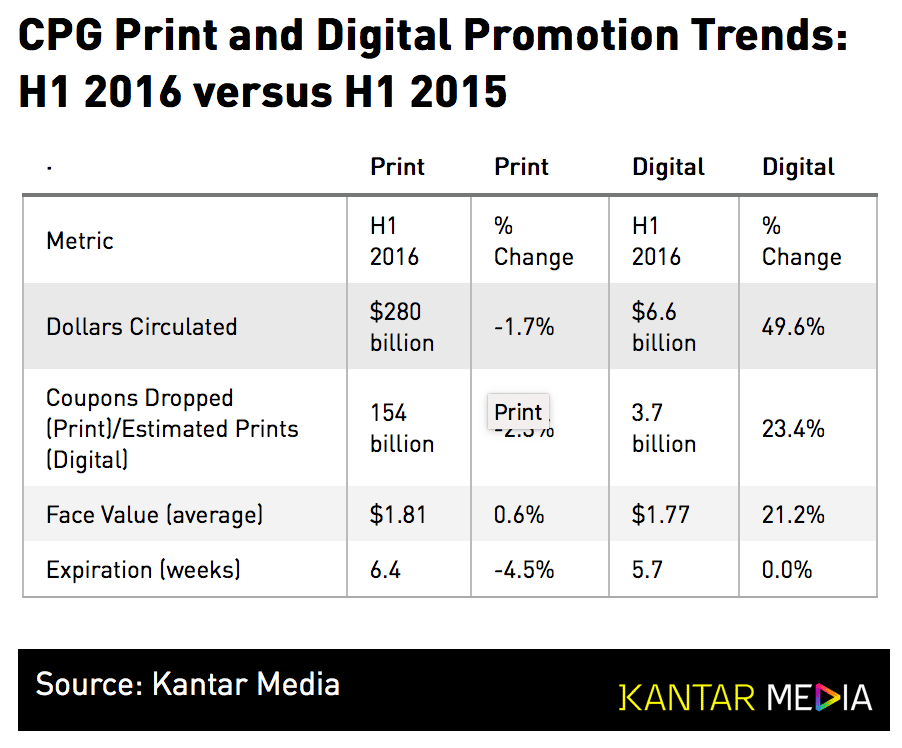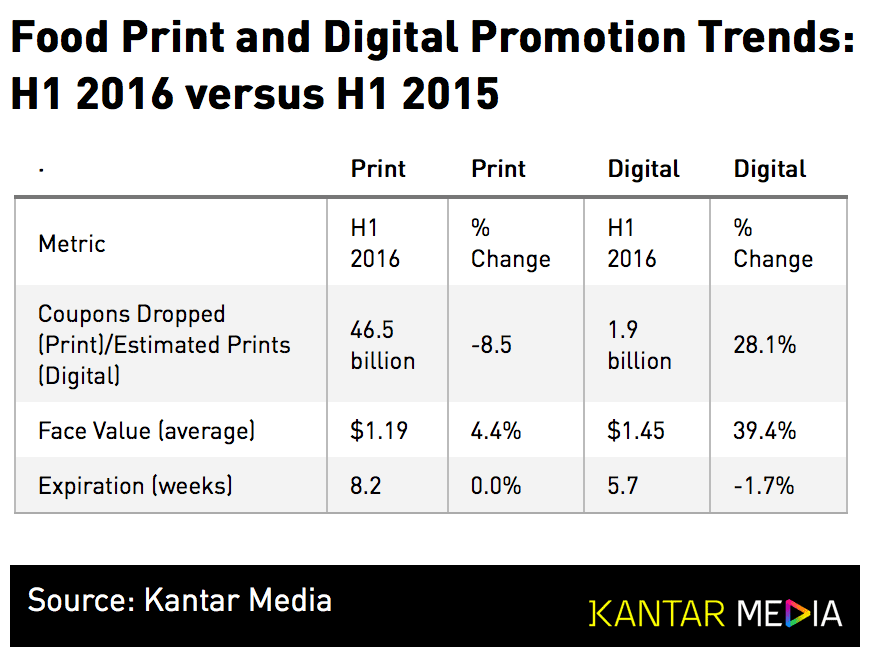CPG digital coupon circulation grows by 23.4% in first half of 2016
August 17, 2016
![]() Kantar Media announced the average face value of digital coupons issued for Consumer Packaged Goods brands increased by 21.2% in the first half of 2016, compared to the same period last year, far outpacing the increase of 0.6% registered by print coupons.
Kantar Media announced the average face value of digital coupons issued for Consumer Packaged Goods brands increased by 21.2% in the first half of 2016, compared to the same period last year, far outpacing the increase of 0.6% registered by print coupons.
According to the report, while the face values of print coupons distributed through Free Standing Inserts, SmartSource Coupon Machines and Consumer Magazines was higher than that of digital coupons distributed through Network and Retailer websites, the gap is narrowing.
Kantar Media also reported that for the period, the number of digital coupons estimated to be printed grew by 23.4% to 3.7 billion. Print coupons still represented the majority of brand promotion activity in the first half of 2016 by far, accounting for 154.7 billion coupons dropped.
The number of estimated prints for digital promotions and the number of coupons dropped for print are key measures of overall brand promotion activity.

“The use of digital promotions and coupons are still changing how CPG brands promote their products, but the tactics used across both digital and print media are becoming more defined and consistent,” said Lisa Ekstedt, Account Solutions Manager. “Print promotion continues to have the largest reach to consumers while digital offers a more targeted approach. In the first half of 2016, manufacturers continued to experiment to find the right combination of face value, expiration and number of offers in the marketplace that will reward and motivate consumers, but not diminish ROI.”
Timing and Seasonality
The most active weeks for promotion in the first half of 2016 surrounded holidays. The week of January 3 had the most activity within print promotion as many manufacturers in Dry Grocery and Health Care tried to leverage consumer interest in New Year’s resolutions.
For digital promotion, the post-Easter drop of April 3 was the most active week to date, with high levels of coupon prints from Dry Grocery, Personal Care and Household Products, perhaps reflecting consumer spring cleaning routines.
Another increase in activity levels within print and digital promotion occurred the week of May 1, prior to Cinco de Mayo and Mother’s Day.
The timing of activity spikes also tended to occur near the 1st of the month, as brands and retailers look to align with consumer pay cycles.
Shifting Activity between Food vs. Non-Food Promotions
Across Total Packaged Goods (Total CPG), Food registered the largest increase in Digital Promotion activity, driven by the Dry Grocery and Cereals categories. In particular, the Dry Grocery category exemplified the trend of shifting activity from print to digital. The category demonstrated the largest decline in print activity while showing the largest increase in digital promotion across all Food categories.
Digital activity now represents 4% of all coupon promotion within the Food sector, an increase from 3% during the first half of 2015. While Food only represents 30% of all print coupons dropped, Food represents 51% of all digital estimated prints.

Non-Food activity was flat in print and increased in digital promotion. Non-Food activity was dominated by Personal Care promotions, which showed the second largest increase in digital and largest increase in print across Total CPG.
Non-Food continued to represent the largest share of coupons dropped in print promotion (70%) while representing 49% of estimated prints in digital.

“As digital activity increases on retailer websites, food brands are taking a more targeted approach, circulating more digital offers. Meanwhile, non-food products continue to rely upon the higher reach of print, and can offer higher value incentives due to the nature of the product’s higher relative cost,” said Kantar Media Vice President Kurt Palmquist.































